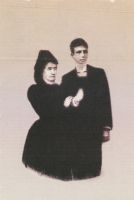Marcela Gracia Ibeas
Marcela Gracia Ibeas and Elisa Sánchez Loriga are considered to be the forerunners of homosexual marriage in Spain. Marcela and Elisa met during their studies in the Normal School for Teacher Training in A Coruña, and their friendship developed into a more intimate relationship. Marcela’s parents tried to separate them by sending Marcela to study in Madrid. However, Marcela returned to work as a teacher in Galicia, where she was reunited with Elisa and they began to live together.
They were married in the church in A Coruña, and to do so, Elisa adopted a masculine identity. When, soon after, it was discovered that they were both women the couple made newspaper headlines. As a result, Marcela and Elisa lost their jobs, were excommunicated, and an arrest warrant was put in place. However, the marriage certificate was never annulled. The Spanish Civil Guard pursued them and in their flight they passed through Vigo and Oporto. They were imprisoned in Oporto, then tried and freed. Their story took another great geographical leap and they moved to Argentina since the Spanish government was seeking to extradite them from Portugal. They died in Argentina.
As Virgina Garzón states, “This is the story of two women who dared to defy the social, moral and religious norms of the time in which they lived. The protagonists are an example of conviction, commitment and courage, but, above all, of deep love”.
Chronology
Elisa Carmen Sánchez Loriga was born in A Coruña on September 8th 1862. Marcela Gracia Ibeas was baptised in the city of Burgos on June 27th 1867 and lived in an orphanage for ten years until she was legitimated and her parents married.
Elisa and Marcela met in the mid-1880s, when Elisa was approximately 23 years old and Marcela 18, and they were both studying teacher training in A Coruña. After a period of time during which Marcela studied in Madrid, they were reunited when they were both sent to be rural teachers in two small parishes of A Coruña.
In order to be able to get married, Elisa adopted a masculine appearance, invented a past and became Mario, using the name of a cousin of hers who had died in a shipwreck. They married on June 8th 1901 in a central church in A Coruña.
Once their marriage had come to light, they were pursued and fled to Oporto, where Marcela gave birth to a girl. From Oporto they fled to Argentina, where they also encountered difficulties and decided that one of them should marry a man to hide their relationship and stay together. In 1903 Elisa Sánchez Loriga (who in Argentina was known as María Sánchez Loriga) married Christian Jensen, a man 24 years her senior, as a strategy to settle in a home to which Marcela (under the identity of Carmen) would later arrive, masquerading as her sister. With time, and with Elisa’s (Maria’s) refusal to consummate the marriage with her husband, the latter became suspicious, leading him to make inquiries and discover that María and Carmen were, in fact, the famous Elisa and Marcela who had appeared in the press some time ago.
Once again they found themselves in court since Jensen tried to annul their marriage. The ruling was that the marriage, on this occasion, was valid, on account of it being between a man and a woman, and consequently there were no charges against Elisa (María). From this point (1904), the trace of these determined lovers is lost. In 1909 the Mexican press announced the death of Elisa: she had taken her own life. Nothing is known of Marcela.
Sources of information
- Narciso de Gabriel. Elisa y Marcela: más allá de los hombres. (Elisa and Marcela: beyond men) Barcelona: Libros del Silencio, 2010.
- La voz de Galicia. La primera boda sin hombre (The first marriage without a man). At: http://www.lavozdegalicia.es /hemeroteca/ 2001/06/08/603476.shtml [20 August 2013]
- El país. Marcela y Elisa, casadas en 1901 (Marcela and Elisa, married in 1901). At: http://elpais.com/diario/2010/03/14/eps/1268551610_850215.html [25 September 2013]
- Virginia Garzón. Desconocidas y fascinantes: Elisa y Marcela con Virginia Garzón (Unknown and fascinating: Elisa and Marcela with Virginia Garzón). At: http://inoutradio.com/desconocidas/2013/07/08/desconocidas-y-fascinantes-elisa-y-marcela-con-virginia-garzon/ [25 September 2013]
Photo:
- Marcela Gracia Ibeas. Publish on 'La Voz de Galicia'. 1901.. Public Domain (copyright expired). Wikimedia Commons. http://commons.wikimedia.org/wiki/File:Marcela_y_Elisa.jpg.




